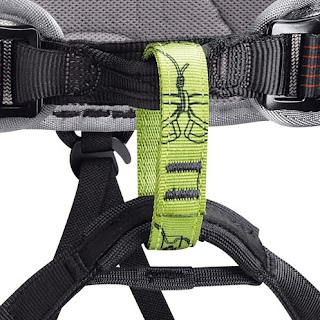The abseil is perhaps the best part of climbing. It's the reward after the strenuous effort of reaching the top. It's what people who didn't do it think climbing is all about - it's the fun stuff.
However, if you want to enjoy the full pleasure of rappelling you must spread your legs... Oh yeah!
Let's talk geometry and make this sound more complicated than it really is. In other words, let's mathematically demonstrate why you need to spread your legs while rappelling. (I do get pretentious and overly scientific sometimes.)
You'll knock yourself out (literally) if you don't spread them
If you've tried to abseil down a rope and kept your feet close together you may have swung either to the left side or to right side, hitting your shoulders against the rock face. This happens for a very simple reason: when your feet are close they act as a single point of contact.
So one point consists of your feet on the cliff and the other point is your anchorage point where the rope is tied - it can be a chain lower off in a route, a tree on the cliff, etc. Now, imagine a line between these two points - this is the axis around which you swing when you have your feet too close (so close that they act as a single contact point).
Why is that? Because two points determine an infinity of planes. As you can see in the image below, the two points are contained both in plane A as well as in plane B. And between these two planes there is that infinity of planes that we've just mentioned above. Rotate either of the planes around the axis made by the two points and you got yourself a new plane.
The axis is represented horizontal but in a real life rappel sitaution this axis is vertical.
Three points determine a single, unique plane
If your legs are spread and your feet are far apart, you enter a new, stable situation. The point on your harness on which you have your descender (abseil eight, Grigri, Reverso, etc.) is a distant corresponded of the anchorage point. That's why we'll consider the third point (see picture below post title) to be on your harness belay loop.
Photo credit: www.supertopo.com
So yes, rappelling with your legs spread gives you more stability. It's a no brainer but the simple geometry lesson is supposed to make you understand the basic principle behind this stability.
There can only be just one plane which contains any three given points in space. Your two feet and your descending device create that plane, preventing you from swinging sideways.
As a beginner climber you will always be tempted to hold both your hands on the rope when you are being lowered by your partner (in top rope climbing for instance). So the usual thing you do when you begin to swing sideways - coz you keep your feet too close to each other - is to grasp even tighter that rope and just wait (or maybe close your eyes and scream as well) to... BANG! You hit the wall with your hip, shoulder and say to yourself: Gee, climbing is dangerous...
Don't feel embarrassed. We all went through it. :-) Remember the three points of contact rule, spread your legs and you 'll be fine.
So, did you enjoy your first abseil? What about your geometry classes?
Thanks for stopping by! Share this article with your friends.












0 Comments :
Post a Comment
Please use your personal name and NOT your business name to comment. Enjoy the blog, the T-shirt designs and thanks for joining the conversation!